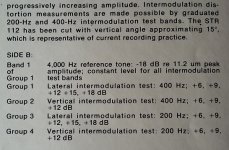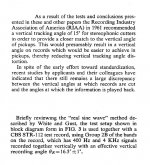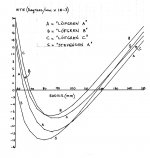It will need a skilled programmer to put the needed computations in software, but it will be possible.I would really appreciate your read on that CBS Labs patent. From a quick look the post processing is trivial in software and having correct VTA as a simple computation from a test track would be nice. The patent has expired so we can do whatever works.
The question is though, what to do with the outcome ?
One wrinkle mentioned in the patent is that mistracking also induces 400Hz FM, when one thinks about it the stylus is taking a different path and so must change relative speed. So need to avoid mistracking, unless that is considered a feature........or reject it...... .......the phase of FM modulation is different between mistracking and tracking angle error conditions - it happens at a different time in the 400Hz cycle. So it could also be a very fine test of the onset of mistracking, when the stylus rides up one groove wall only..........or ignored if one can guarantee no mistracking.
LD
There are going to some details for sure, would it help if I posted an actual recording of one of these? Which would be most useful? IIRC the +18dB ones had obvious problems that would probably obscure the answer.
Attachments
Last edited:
The question is though, what to do with the outcome ?
I would hope a direct read on the necessary corrections for optimum stylus alignment.
What should that correction be, because seemingly there are many different cutting angles around.I would hope a direct read on the necessary corrections for optimum stylus alignment.
Using the CBS STR-112 only guarantees that VTA is adjusted correctly just for this single LP because its cutting angle is known to be 16.5 degrees.
Or is my view too pessimistic ?
Hans
It's both, and all. Turntable speed and stability, cart and arm setup and measurement, preamp measurement.I read most of the post some are a little hard for me too follow but i dont recall seeing the objectives set out. Is this a record to setup the cart/ arm / table optimally or is a record to measure the performance of reproduction chain including the preamp?
As far as I recall the original goal was just to get a test LP with the tests we wanted, and at a reasonable price. A well centered disk was also hoped for. 🙂
It is thought that this would be a test LP mostly used by people with computers, a good sound card and some software. Other test gear could certainly be used. Some tracks will be specifically meant for software analysis.It would be good to agree on what type of instruments will most folks use .... 2ch oscilloscope is probably the minimum, some might have distortion meter, some might have spectrum analyser or FfT, some might digitize and apply the above in software.
Another bonus of this test LP is that the production will be as transparent as possible. We have the discussion of the tracks here, the original files will be available online, software for analysis will be free, and any technical compromises needed for the mastering, cutting and pressing will be discussed and provided as reference. Even test LPs are not perfect, so we will explain any imperfections we find so that the user can take these into account.
My guess is that we will have to stick with cutting angle used by the mastering house. Knowing what that is, is a good starting point and maybe other angles could be deduced from the test. It's a question I will ask the mastering house. Slowly making progress there.What should that correction be, because seemingly there are many different cutting angles around.
I'd say group 1 and group 2 (440Hz) at +6 and +9 dB.Which would be most useful?
Using the CBS STR-112 only guarantees that VTA is adjusted correctly just for this single LP because its cutting angle is known to be 16.5 degrees.
Or is my view too pessimistic ?
I think it said 15 degrees but it's a well calibrated point. You could set what you want off of that point. VTA for each LP? I don't go there but I've seen plenty of folks obsessing over this as well as the centering of each LP.
The main reason small changes in VTA adjustment can have profound effect on audible performance is that stylus rake angle can be critical to stylus-groove contact mechanics and friction. That's my long considered opinion, anyway. Less to do with the geometric distortion at issue here, contrary to common wisdom.
Nevertheless, much of the total harmonic distortion in real playback arises from mismatched VTA due to geometric tracing errors. It's not just pure vertical motion that's affected: any stylus motion with a vertical element, such as hard panned single channel sound, incurs the distortion.
Soo it's worth getting VTA as matched as possible, though that's a moving target since records are cut with various VTA and record thickness varies.
If all is at peace with one's cartridge, optimal stylus-groove friction and an optimal VTA occur at a single angle. However, if this is not the case, one gets more audible benefit from getting friction minimised, if it has to be a choice.
A significant problem with our test method here is calibration: we won't necessarily know the actual cut VTA of the test record..........
Calibration is far easier for lateral tracking angle test using the same method, because we know the nominal cut offset angle is zero. The lateral test is well worth doing as a cartridge alignment tool, and may be helpful with VTA test SW calibration if the same recorded levels are used for vertical and lateral tests.
LD
Nevertheless, much of the total harmonic distortion in real playback arises from mismatched VTA due to geometric tracing errors. It's not just pure vertical motion that's affected: any stylus motion with a vertical element, such as hard panned single channel sound, incurs the distortion.
Soo it's worth getting VTA as matched as possible, though that's a moving target since records are cut with various VTA and record thickness varies.
If all is at peace with one's cartridge, optimal stylus-groove friction and an optimal VTA occur at a single angle. However, if this is not the case, one gets more audible benefit from getting friction minimised, if it has to be a choice.
A significant problem with our test method here is calibration: we won't necessarily know the actual cut VTA of the test record..........
Calibration is far easier for lateral tracking angle test using the same method, because we know the nominal cut offset angle is zero. The lateral test is well worth doing as a cartridge alignment tool, and may be helpful with VTA test SW calibration if the same recorded levels are used for vertical and lateral tests.
LD
It would be very interesting to see linear tonearm effect on turntable speed stability. If I remember there were no measurements of linear tracking arm in 'Turntable Speed stability' thread. I will search that thread when time permits.Whilst that is mechanically possible, you would have to optimise for one particular arm length and alignment, so would be a heroic bit of engineering for a reduced market share. It would be easier to rotate the cutting head to get the same effect.
Better would be to persuade people to use linear tracking arms!
Regards.
A significant problem with our test method here is calibration: we won't necessarily know the actual cut VTA of the test record..........
Maybe someone could volunteer to use one of the more tedious methods to determine the cut VTA. IIRC I saw somewhere using a USB microscope-cam and software to get 0.1 degree resolution on SRA.
Image below shows what is written in the VTA patent application.
Riaa recommendation for VTA is 15 degrees, but large discrepancies do exist and according to this document the STR-112 is cut with 16.5 +/- 1 degree ??
Others say the STR-112 is cut with 15 degrees. So what will it be and what does 0.1 degree measuring accuracy mean in that case ?
I can see with my Dr Feickert test record that small changes in VTA do have large effects in phase relation between the two channels, so I tend to agree with LD that VTA might not be the most important parameter.
Hans
Riaa recommendation for VTA is 15 degrees, but large discrepancies do exist and according to this document the STR-112 is cut with 16.5 +/- 1 degree ??
Others say the STR-112 is cut with 15 degrees. So what will it be and what does 0.1 degree measuring accuracy mean in that case ?
I can see with my Dr Feickert test record that small changes in VTA do have large effects in phase relation between the two channels, so I tend to agree with LD that VTA might not be the most important parameter.
Hans
Attachments
Last edited:
Image below shows what is written in the VTA patent application.
Riaa recommendation for VTA is 15 degrees, but large discrepancies do exist and according to this document the STR-112 is cut with 16.5 +/- 1 degree ??
I was only going by the insert that came with my copy (post #282). We can only do so much with these tests and maybe hoping that the phase and magnitude of the IM will yield a sweet spot is too much. In the end stylus geometry will probably enter into it and there will not be enough degrees of freedom for a pat answer.
Is there a measurable sweet spot in the 400+4K signal that shows the optimum VTA for that particular disk?
Yes, there should be a sweet spot where 400Hz FM modulation of the 4kHz tone is a minimum. Just need to keep the amplitudes big enough to show an effect and small enough to guarantee perfect tracking. There's also a case for moving the carrier up to 8kHz or 10kHz, methinks.
If we include exactly the same amplitude lateral test tone, not only will it provide a means of checking arm/cart tracking offset alignment, but also provide a means of calibrating the VTA test alignment........
If we measure the lateral 400Hz FM at 0 degs, we can then intentionally misalign the lateral tracking offset angle by say, -10, -5, -2.5, +2.5, +5, +10 degrees (by rotating the cartridge) and calibrate the whole system.
Et voila
The lateral test track would need to be at a common null point on the record.
LD
If we include exactly the same amplitude lateral test tone, not only will it provide a means of checking arm/cart tracking offset alignment, but also provide a means of calibrating the VTA test alignment........
If we measure the lateral 400Hz FM at 0 degs, we can then intentionally misalign the lateral tracking offset angle by say, -10, -5, -2.5, +2.5, +5, +10 degrees (by rotating the cartridge) and calibrate the whole system.
Et voila

The lateral test track would need to be at a common null point on the record.
LD
Hi luckythedog,
-Chris
With the various protractors in use, I don't think there is a common null point. I guess you could average them out and choose a point close to the majority of alignment protractors. Sounds like work to me.The lateral test track would need to be at a common null point on the record.
-Chris
In trying to find the pretty graph showing the different alignments I found some chewy maths analysing them which might be of interest to some.
Tonearm Geometry Analysis by Graeme Dennes (c) 1983,2015 - Vinyl Engine
The diagram I was thinking of is page 25 of the linked Dennes paper (attached here )
Tonearm Geometry Analysis by Graeme Dennes (c) 1983,2015 - Vinyl Engine
The diagram I was thinking of is page 25 of the linked Dennes paper (attached here )
Attachments
With the various protractors in use, I don't think there is a common null point.
For the purpose of calibrating what we get couldn't someone use a linear tracker? Also I've seen printable protractors on the web, just make one for wherever the track ends up.
Last edited:
Member
Joined 2009
Paid Member
Do we need James Earl Jones to do our voice announce? How about Stephen Fry?
How about Eddie ?
YouTube
- Home
- Source & Line
- Analogue Source
- Test LP group buy


